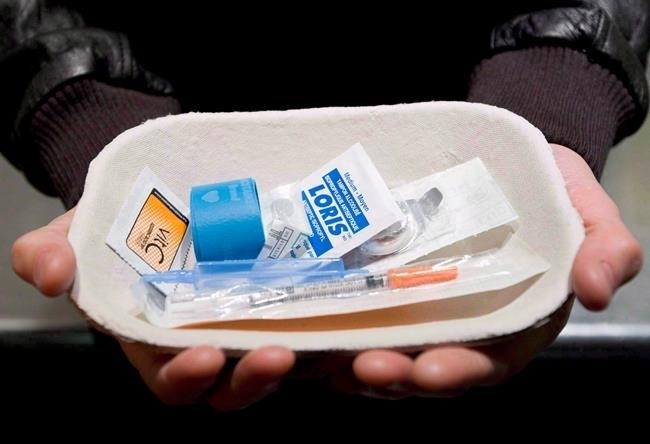
FILE PHOTO - An injection kit is shown at Insite, a safe injection facility in Vancouver, on Tuesday, May 6, 2008.
Image Credit: THE CANADIAN PRESS/Jonathan Hayward
December 01, 2016 - 1:13 PM
KAMLOOPS - As part of the plan to deal with the drug overdose crisis, the Interior Health Authority wants to have mobile illicit drug consumption units on the streets of Kamloops and Kelowna as soon as possbile.
Along with the mobile unit, the plan from Interior Health also includes a safe consumption site at the Ki-Low-Na Friendship Society in Kelowna.
Chief Medical Officer Dr. Trevor Corneil says they will likely use vans or similar vehicles for the mobile units, though much still has to be determined, including a budget. He figures each mobile unit will cost between $200,000 to $700,000.
“We want to spend the amount of money that would make for an effective service,” he says. “If it gains traction then we’ll grow it from there. It's like saying we’d like to start with the Volkswagen and then look at a Mercedes if it works.”
The bulk of expense would be the capital cost to purchase the vehicles and the gear to outfit them, which would include clean needles, harm reduction equipment, first aid supplies and naloxone kits.
Corneil says there will be no drugs at the safe consumption site or the mobile units, nor will health care workers inject patients with illicit drugs. They will be there to observe and assist if things go wrong. Additional staff could be added as well, including a social worker to connect site users with services, a physician to perscribe antibiotics and a mental health councillor.
While there are no mobile safe consumption units operating in Canada yet, Corneil says a Danish operation called a Fixerum is similar to what he foresees in B.C.
The worker in the mobile unit would also be looking to build a relationship with users, he says, and to offer people with addictions access treatment.
Interior Health is exploring the ability to test drugs people bring to the sites for fentanyl, the powerful opioid behind many of the overdoses in B.C. Corneil says currently the testing strips in use aren’t perfect, but they’re better than nothing.
“If it’s 80 per cent accurate that’s better than the Russian roulette people are playing with drugs from the black market,” he says.
The reason for mobility in Kamloops and Kelowna is partially due to how overdoses and users are spread across both population centres.
“We actually found the use is really distributed, it’s not ghettoized,” he says. “In Kamloops it’s really evenly distributed on the North Shore and South Shore. In Kelowna there’s a small majority that happens in the downtown core area.”
The decision also took into account feed back from stakeholders like RCMP, municipal governments and illicit drug users.
Find past stories on fentanyl crisis here.
Get caught up on the overdose issue here.
To contact a reporter for this story, email Brendan Kergin or call 250-819-6089 or email the editor. You can also submit photos, videos or news tips to the newsroom and be entered to win a monthly prize draw.
We welcome your comments and opinions on our stories but play nice. We won't censor or delete comments unless they contain off-topic statements or links, unnecessary vulgarity, false facts, spam or obviously fake profiles. If you have any concerns about what you see in comments, email the editor in the link above.
News from © iNFOnews, 2016